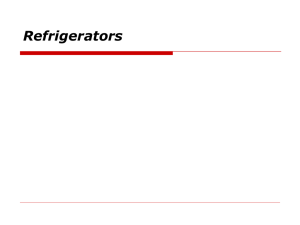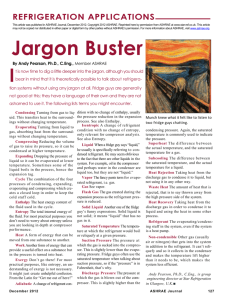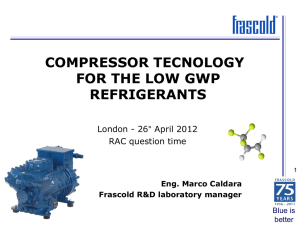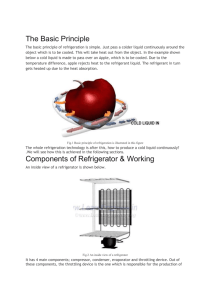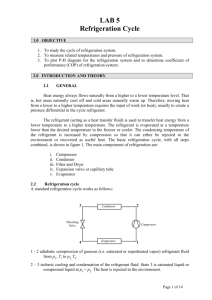THERMODYNAMICS LAB 4 – Thermal Conductivity and Heat Transfer
advertisement
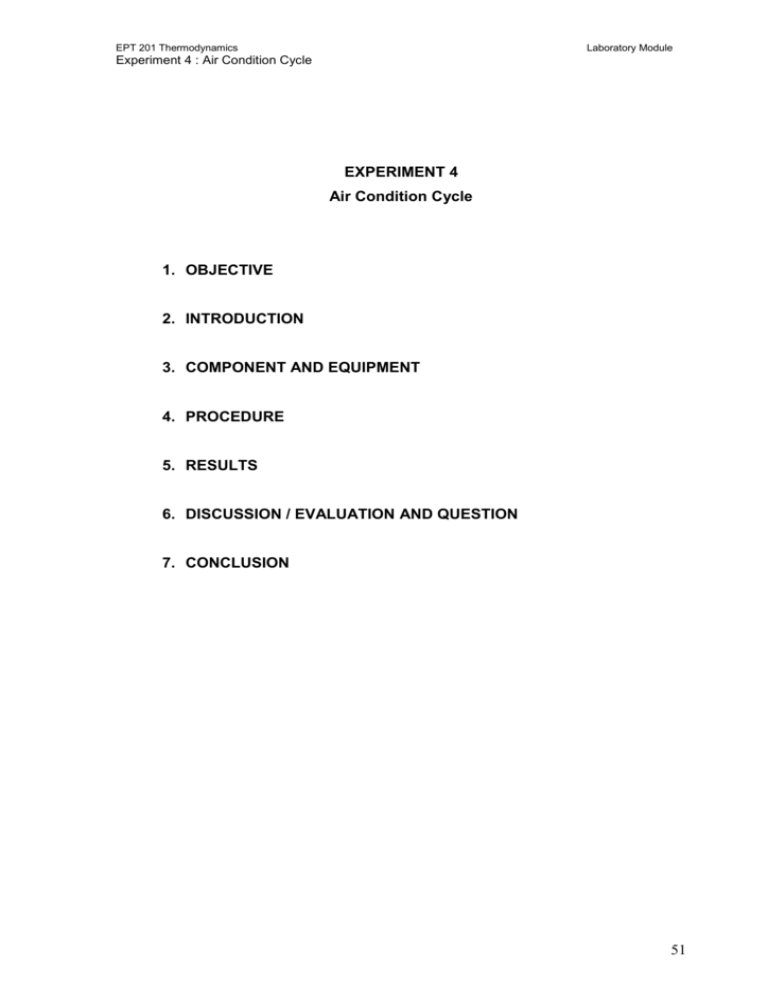
EPT 201 Thermodynamics Laboratory Module Experiment 4 : Air Condition Cycle EXPERIMENT 4 Air Condition Cycle 1. OBJECTIVE 2. INTRODUCTION 3. COMPONENT AND EQUIPMENT 4. PROCEDURE 5. RESULTS 6. DISCUSSION / EVALUATION AND QUESTION 7. CONCLUSION 51 EPT 201 Thermodynamics Laboratory Module Experiment 4 : Air Condition Cycle EXPERIMENT 4 Air Condition Cycle 1. OBJECTIVE 1.1 To study the cycle of Air Conditioner system. 1.2 To measure related temperatures and pressure of Air Conditioner system 1.3 To plot P-H diagram for the refrigeration system and to determine coefficient of performance (COP) of Air Conditioner system 2. INTRODUCTION 2.1 Background An air conditioner (A/C) is an appliance or mechanism designed to extract heat from a humanly occupied space air temperature using a refrigeration cycle. Airconditioning was invented by Willis Haviland Carrier ( 1876 – 1950 ) around 1902 to control temperature and humidity for improved manufacturing process control. Later, airconditioning was applied to increase productivity in the workplace. Later still, air conditioning use was expanded to improve comfort in homes and automobiles. Figure 1 : Air Conditioner –Split Unit 52 EPT 201 Thermodynamics Laboratory Module Experiment 4 : Air Condition Cycle Air conditioning equipment usually reduces the humidity of the air processed by the system. Since humans perspire to provide natural cooling by the evaporation of perspiration from the skin, drier air improves the comfort provided. The comfort air conditioner is designed to create a 40% to 60% relative humidity in the occupied space. Air conditioners and refrigerators work the same way. Instead of cooling just the small, insulated space inside of a refrigerator, an air conditioner cools a room, a whole house, or an entire business. Air conditioners use chemicals that easily convert from a gas to a liquid and back again. This chemical is used to transfer heat from the air inside of a home to the outside air. An air conditioning system generally consists of five mechanical components: 1. A compressor 2. A fan 3. A condenser coil (hot) 4. An evaporator coil (cool) 5. A chemical refrigerant The compressor and condenser are usually located on the outside air portion of the air conditioner. The evaporator is located on the inside the house. The processes that happen in air conditioner system are: 1. The working fluid arrives at the compressor as a cool, low-pressure gas. The compressor squeezes the fluid. This packs the molecule of the fluid closer together. The closer the molecules are together, the high its energy and its temperature. 2. The working fluid leaves the compressor as a hot, high pressure gas and flows into the condenser. The condenser consists of metal fins all around. The fins act just like a radiator in a car and help the heat go away, or dissipate, more quickly. 3. When the working fluid leaves the condenser, its temperature is much cooler and it has changed from a gas to a liquid under high pressure. The liquid goes into the evaporator through a very tiny, narrow hole. On the other side, the liquid's pressure drops. When it does it begins to evaporate into a gas. 53 EPT 201 Thermodynamics Laboratory Module Experiment 4 : Air Condition Cycle 4. As the liquid changes to gas and evaporates, it extracts heat from the air around it. The heat in the air is needed to separate the molecules of the fluid from a liquid to a gas. The evaporator also has metal fins to help in exchange the thermal energy with the surrounding air. 5. By the time the working fluid leaves the evaporator, it is a cool, low pressure gas. It then returns to the compressor to begin its trip all over again. Connected to the evaporator is a fan that circulates the air inside the house to blow across the evaporator fins. Hot air is lighter than cold air, so the hot air in the room rises to the top of a room. There is a vent there where air is sucked into the air conditioner and goes down ducts. The hot air is cooled by the gas in the evaporator. As the heat is removed from the air, the air is cooled. It is then blown into the house This continues over and over and over until the room reaches the temperature you want the room cooled to. The thermostat senses that the temperature has reached the right setting and turns off the air conditioner. As the room warms up, the thermostat turns the air conditioner back on until the room reaches the temperature. 2.2 The Air Conditioner Cycle The Air conditioners cycle works the same way as refrigeration cycle. The process is similar to each other. The refrigerant (acting as a heat transfer fluid) is used to transfer heat energy from a lower temperature to a higher temperature. The refrigerant is evaporated at a temperature lower than the desired temperature in the freezer or cooler. The condensing temperature of the refrigerant is increased by compression so that it can either be rejected to the environment or recovered as useful heat. The basic air conditioner cycle, with all steps combined, is shown in figure 2. The standard refrigeration cycle works as follows: 54 EPT 201 Thermodynamics Laboratory Module Experiment 4 : Air Condition Cycle Figure 2 1-2 adiabatic compression of gaseous (i.e. saturated or superheated vapor) refrigerant fluid from p1, T1 to p2, T2. 2–3 isobaric cooling and condensation of the refrigerant fluid. State 3 is saturated liquid or compressed liquid at p3 = p2. The heat is rejected to the environment. 3–4 adiabatic throttling to p4 = p1. The throttling process is isenthalpic, h3 = h4. 4–1 isobaric evaporation (and possibly superheating) of the refrigerant fluid, back to state 1. The refrigeration cycle can be divided into four phases with all phases is combined in closes system. These four steps are: Step 1, Evaporation: Liquid refrigerant at a sufficiently low pressure is brought into contact with the heat source (the medium to be cooled). The refrigerant absorbs heat and boils, producing a lowpressure vapor. The heat exchanger used for this process is called the evaporator. Step 2, Compression: The compressor raises the pressure of the refrigerant vapor, normally using an electric motor drive. This increases the temperature at which the vapors will condense to a temperature above the temperature of the heat sink. Most common compressors are reciprocating (piston and cylinder) or screw (looking much like an old meat grinder) compressor designs. 55 EPT 201 Thermodynamics Laboratory Module Experiment 4 : Air Condition Cycle Step 3, Condensing: The high-pressure refrigerant gas now carrying the heat energy absorbed at the evaporator plus the work energy from the compressor enters the condenser. Since the refrigerant's condensing temperature is higher than that of the heat sink, heat transfer will take place, condensing the refrigerant from a high-pressure vapor to a high-pressure liquid. Step 4, Expansion: The condensed liquid's pressure is reduced (called "throttled") to the lower pressure evaporator using a valve, orifice plate or capillary tube device. In actual practice, the condenser cools the refrigerant a bit more, sub cooling it below the condensing temperature. This is an important efficiency improving attribute to the cycle, since it reduces the amount of refrigerant liquid that has to evaporate (it is called flashing at this stage in the cycle) to a gas in the expansion valve to reduce the pressure and temperature of the liquid entering the evaporator. This reduction in flash gas is important to improve system performance. The refrigeration process flow is described below: a) Compressor starts. b) Low pressure vapour refrigerant is compressed and discharged out of the Compressor. c) The refrigerant, at this time is at High Pressure. d) The refrigerant flows through the discharge line to the condenser. e) The condenser gives up heat absorbed and changes from vapour to liquid f) The high pressure liquid then flows through the Filter Drier to the Thermal Expansion Valve(TXV) or Capillary tube. g) The Thermal Expansion Valve (TXV) control the liquid refrigerant into the Evaporator. h) As the refrigerant flows through the expansion device, changes to Low Pressure liquid. i) In the Evaporator, heat is absorbed and the refrigerant begin to change in state from liquid to vapour. j) The low pressure vapour refrigerant moves back to the compressor. k) The cycle start over again 56 EPT 201 Thermodynamics Laboratory Module Experiment 4 : Air Condition Cycle 57 EPT 201 Thermodynamics Laboratory Module Experiment 4 : Air Condition Cycle 2.2 Pressure-Enthalpy Diagram The Pressure-Enthalpy (P-H) diagram is another way of looking at the refrigeration cycle. It has the advantage of graphically showing the process, the cooling effect and the work required to make it happen. Figure 2 : P-H Chart Figure 2 shows the Pressure-Enthalpy (PH) diagram for the refrigeration. The process for each of the components is indicated. Point 1 to 2 - Compression process. The work is the change in enthalpy from point 1 to point 2. Simply, Btu/lb. times the lb./min equals compressor power. Compressors end up with the work of compression as heat in the refrigerant. The vertical aspect of the curve shows the rise in refrigerant pressure (and temperature) from 1 to 2. Point 2 to 3 - Condensation process. The process takes place in the condenser. Once the refrigerant is saturated, condensation occurs and the refrigerant changes from a gas to a liquid. Like the evaporator, the line is horizontal indicating constant pressure. 58 EPT 201 Thermodynamics Laboratory Module Experiment 4 : Air Condition Cycle Point 3 to 4 - Expansion process. The process is happen in expansion device such expansion valve or capillary tube. This appears as a vertical line from point 3 to point 4, indicating the pressure (and temperature) drop that occurs as the refrigerant passes through the capillary tube. Point 4 to 1 - Evaporation process. The evaporator process is from point 4 to point 1. As the refrigerant changes from a liquid to gas, the pressure (and temperature) stays constant. The heat is being absorbed as a phase change (latent energy). The refrigeration effect is the change in enthalpy from 4 to 5, simply expressed as Btu/lb.. 2.3 Analysis and calculation For the calculations involved, take readings of properties directly from the pressure–enthalpy diagram. By applying the energy equation to a compressor, we get the following equation assuming that the process is adiabatic (compressor work in kJ/kg) Based on pressure –enthalpy diagram, several quantities of interest can be determined using the first law and the second law of thermodynamics. These quantities include the following. i. The heat absorb by the evaporator, QL QL ii. = h2 – h3 The actual work required, Wa (the input work to the compressor): wa iv. h1 – h4 The heat rejected from the condenser, QH QH iii. = = h2 – h1 The coefficient of performance (COP) of the refrigeration system: COP = QL / wa COP = h1 - h4 h2 - h1 The higher COP is the better. COP = 2 mean that refrigeration removes about 2 units of thermal energy from the refrigerated space for each unit of electric energy is consumes. 59 EPT 201 Thermodynamics Laboratory Module Experiment 4 : Air Condition Cycle 60 EPT 201 Thermodynamics Laboratory Module Experiment 4 : Air Condition Cycle 3. COMPONENT AND EQUIPMENT Figure 3: Air Conditioner Trainer 61 EPT 201 Thermodynamics Laboratory Module Experiment 4 : Air Condition Cycle 4. PROCEDURE No. 1. 2. 3. 4. 5. 6. 7. Procedure Fully open valve all valves. Switch ‘ON’ Power supply. Wait about 5 minutes until the system is stabile. Record the power of the compressor. Record the pressure: i. High pressure (HP) - Red gauge ii. Low pressure (LP) - Blue gauge The pressure need to add 1 bar for atm pressure consideration. Take the temperature probe. At Compressor : i. Measure temperature at compressor inlet ( T1) ii. Measure temperature at compressor outlet ( T2) 8. At Evaporator i. Measure temperature at before entering capillary tube ( T3) ii. Measure temperature before Evaporator outlet ( T evaporator ) 9. 10. 11. 12. 13. Record the Refrigerant flow rate at flow meter. Fill data in Table 1. Using P-H diagram, Plot your data referring to figure 2. From the P-H diagram, determine the enthalpy (h) at the all points measured. End of Experiment 62 EPT 201 Thermodynamics Laboratory Module Experiment 4 : Air Condition Cycle Name :____________________________________ Matrix No. : ____________________________________ Date :____________________________________ 5. RESULTS No. Description Pressure (bar) 1. 2. No. High Pressure ( HP) + 1 bar (atm) Low Pressure (LP) + 1 bar (atm) Description 3. 4. 7. 8. No. 9 Temperature at compressor inlet ( T1) Temperature at compressor outlet ( T2) Temperature at before capillary tube ( T3) Temperature at Evaporator ( Tevaporator) Description Flow rate Temp. (ºC) l/min Table 1 Note : 1. 2. 3. 4. 5. 6. Using given P-H diagram, Plot your data referring to figure 2. Step 1 : Draw the horizontal line of High pressure (HP) Step 2 : Draw the horizontal line of Low pressure (LP) Step 3 : At Low Pressure (LP) line plot T1. Step 4 : At High pressure (HP) line plot T2 and T3 Step 5 : t point T3 draw vertical line that will cut to LP line. This intersection is point T4. 7. Step 6 : Draw a line that will connecting T1, T2, T3 and T4 . 8. Step 7 : To find the enthalpy ( x-axis), draw the vertical line to the x- axis. The intersection is the enthalpy for that point. 9. Record the enthalpy in table 2 : Point 1 2 3 4 Temperature , ºC Enthalpy (h) , kJ/kg Table 2 63 EPT 201 Thermodynamics Laboratory Module Experiment 4 : Air Condition Cycle 6. DISCUSSION / EVALUATION & QUESTION 6.1 Discuss experimental results. You may use below guidelines: (Include a discussion on the result noting trends in measured data, and comparing measurements with theoretical predictions when possible. Include the physical interpretation of the results and graphs, the reasons on deviations of your findings from expected results, your recommendations on further experimentation for verifying your results, and your findings) 64 EPT 201 Thermodynamics Laboratory Module Experiment 4 : Air Condition Cycle 6.2 Calculated the efficiency of the air conditioning (COP). 6.3 Using your own word explain the function of Compressor in air conditioning system. 6.4 Using your own word explain the function of Condenser in air conditioning system. 6.5 Using your own word explain the function of evaporator in air conditioning system. 6.6 Using your own word describe the whole air conditioning process. 65 EPT 201 Thermodynamics Laboratory Module Experiment 4 : Air Condition Cycle 7. CONCLUSION Based on data and discussion, make your overall conclusion by referring to experiment objective. 66

